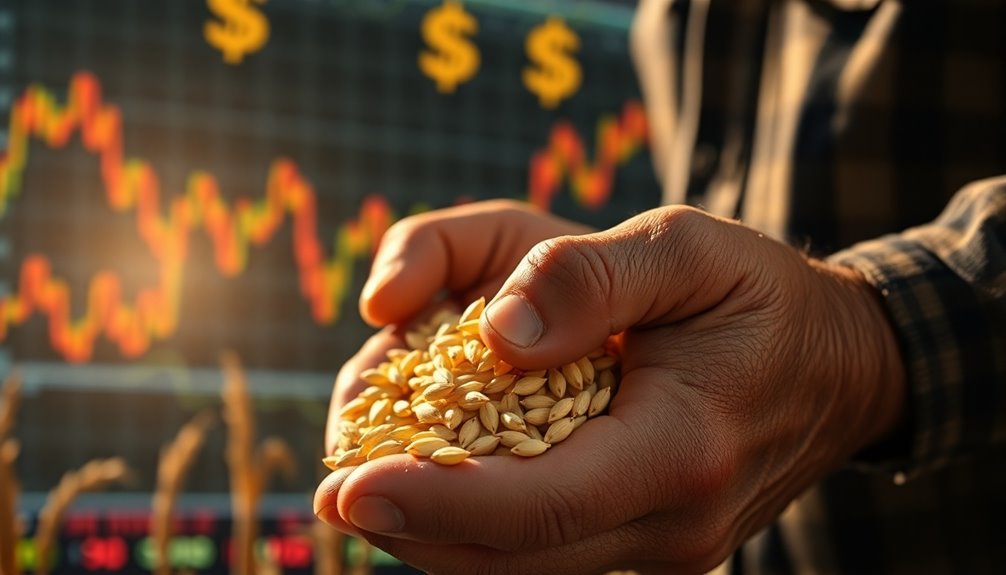Yield farming is a strategy where you earn passive income by providing liquidity to decentralized finance (DeFi) platforms. You lock or stake your assets in liquidity pools, which rewards you with liquidity provider (LP) tokens. These tokens can then be staked for added rewards, often seen as annual percentage yield (APY). While it can offer high returns, it also comes with risks, like impermanent loss from fluctuating asset values. Understanding how liquidity pools work is vital for successful participation, and there's a lot more to discover about navigating the DeFi landscape effectively.
Key Takeaways
- Yield farming is a DeFi strategy that allows users to earn passive income by providing liquidity to decentralized exchanges (DEXs).
- Participants receive liquidity provider (LP) tokens as proof of their contribution to liquidity pools.
- Staking LP tokens can yield additional rewards, often expressed as annual percentage yield (APY).
- Risks include impermanent loss from fluctuating asset values and vulnerabilities in smart contracts.
- Market demand and conditions significantly influence the potential returns and dynamics of yield farming.
Core Concepts of Yield Farming

Yield farming is a compelling way to earn passive income in the decentralized finance (DeFi) space, where you provide liquidity by depositing your cryptocurrency into liquidity pools.
As a participant, you'll receive liquidity provider (LP) tokens, which serve as proof of your contribution. You can stake these tokens to earn additional rewards, typically measured as an annual percentage yield (APY).
Smart contracts play a crucial role in this process, automating transactions and managing funds securely and transparently. The rewards you earn often include governance tokens, granting you a voice in the protocol's future developments.
However, keep in mind that yield farming is influenced by market conditions and demand for liquidity, making it a dynamic and sometimes unpredictable venture.
Yield Farming Basics Explained

When you lock or stake your cryptocurrency assets in liquidity pools on DeFi platforms, you're essentially entering the world of yield farming. This process allows you to earn passive income by providing liquidity to protocols like Uniswap and Aave.
In return, you receive rewards, typically in the form of additional tokens or governance tokens that grant voting rights. The potential annual percentage yields (APYs) can be substantial, sometimes reaching triple digits.
However, be aware of the risks involved, including impermanent loss, which can occur when asset values fluctuate within the liquidity pool.
Liquidity Provision Mechanics

As you delve into liquidity provision mechanics, it's crucial to understand how your participation in decentralized exchanges (DEXs) impacts trading efficiency.
By depositing your crypto assets into liquidity pools, you facilitate seamless trading while earning rewards. In return for your contribution, you receive liquidity provider (LP) tokens, which represent your stake in the pool.
These tokens allow you to earn transaction fees generated by trades, providing a way to earn passive income. Automated Market Makers (AMMs) like Uniswap and PancakeSwap utilize these liquidity pools, enhancing the DeFi ecosystem by enabling token swaps without traditional order books.
Your rewards as a liquidity provider are usually proportional to your investment, incentivizing greater participation and maintaining the functionality of DeFi platforms.
Pros and Cons Overview

While exploring yield farming, you'll quickly notice its potential for high returns alongside some notable risks.
Yield farming offers impressive annual percentage yields (APYs), often exceeding traditional financial products and reaching triple digits in the DeFi space. As a liquidity provider, you can earn yield farming rewards, creating opportunities for passive income without constant trading.
However, be mindful of the risks of yield, including impermanent loss caused by price fluctuations of pooled tokens. Additionally, smart contract vulnerabilities can lead to significant financial losses if bugs in the code are exploited.
Market volatility and regulatory uncertainty further complicate the landscape, impacting the stability of decentralized trading platforms.
Balancing these pros and cons is essential before diving into yield farming.
Yield Farming vs. Traditional Investing

Yield farming stands out from traditional investing by offering the potential for much higher returns. With annual percentage yields (APYs) often reaching triple digits, it blows typical savings accounts out of the water.
Unlike traditional investing, where accessing your funds can be a lengthy process, yield farming allows for quicker withdrawals, though some protocols might've initial lock periods. However, you should be aware of the volatility in crypto markets, as rapid price fluctuations can lead to significant gains or losses.
Traditional investments usually come with established regulations, whereas yield farming operates in a decentralized DeFi sector, exposing you to risks like rug pulls and smart contract vulnerabilities.
Still, savvy investors can thrive in this dynamic environment.
Market Manipulation Threats

Market manipulation threats in yield farming can pose significant risks for investors navigating this volatile landscape.
Practices like wash trading can mislead you about a token's liquidity and popularity, making it hard to make informed decisions. The decentralized nature of DeFi platforms can shield malicious actors, complicating regulatory scrutiny.
You might also encounter pump-and-dump schemes, where a group artificially inflates a token's price before dumping it, leaving you with worthless assets.
Flash loan attacks exploit price discrepancies, leading to significant losses for liquidity providers.
As these threats grow, expect increased compliance measures and oversight aimed at protecting you and other investors against potential manipulation.
Staying vigilant is essential in this rapidly evolving space.
Emergence of Layer 2 Solutions

As you navigate the risks associated with market manipulation in yield farming, the emergence of Layer 2 solutions offers promising advancements that can enhance your experience.
These solutions, including Optimistic Rollups and zk-Rollups, significantly boost transaction speed and reduce gas fees on Ethereum. By allowing you to conduct transactions off-chain while retaining the main blockchain's security, Layer 2 solutions improve accessibility and user experience.
They've alleviated congestion, leading to a 60% decrease in gas fees, making yield farming more attractive. Additionally, Layer 2 protocols seamlessly integrate with various DeFi applications, promoting liquidity across decentralized exchanges.
This surge in efficiency has also driven a remarkable growth in total value locked (TVL), with an increase of over $10 billion in 2023.
Diversify Across Multiple Platforms

To maximize your potential returns and manage risk effectively, diversifying across multiple yield farming platforms is essential. By spreading your investments across various liquidity pools, you can access different annual percentage yields (APYs), increasing your overall returns.
Engaging with multiple DeFi protocols helps mitigate the impact of impermanent loss, as price fluctuations in tokens may not affect all platforms the same way. This strategy provides a more stable earning potential and protects against the volatility of individual cryptocurrencies.
Additionally, as you diversify, you'll earn various governance tokens, enhancing your influence within the protocols you support. Overall, a well-rounded investment strategy will help you navigate the complexities of yield farming while maximizing your rewards.
Frequently Asked Questions
What Does Yield Farming Mean?
Yield farming means you're providing your cryptocurrency to decentralized finance platforms in exchange for rewards.
You deposit your tokens into liquidity pools, which facilitates trading and lending without needing intermediaries.
In return, you earn additional tokens, often governance tokens that let you have a say in the platform's direction.
The potential returns can be quite high, sometimes surpassing traditional investments, making it an attractive option for many crypto enthusiasts like you.
Is Yield Farming Still Profitable?
Yes, yield farming can still be profitable.
If you're savvy and keep an eye on market conditions, you could find platforms offering high annual percentage yields.
Despite the volatility and risks involved, like impermanent loss, many investors are still raking in returns.
With ongoing advancements in risk management and protocols, you're likely to uncover opportunities that can enhance your profits in the DeFi space.
Just stay informed and cautious!
What Are the Risks of Yield Farming?
When you explore yield farming, be aware of the risks involved.
You might experience impermanent loss if token prices diverge, leading to lower returns.
Smart contract vulnerabilities can expose you to hacks, and rug pulls could leave you with worthless tokens.
Market volatility can also impact your profits during locked periods.
Lastly, keep an eye on regulatory risks, as changes in laws could affect your access to platforms and your investments.
How to Make Money From Yield Farming?
To make money from yield farming, you'll want to choose a high-yield DeFi protocol and deposit your cryptocurrency into liquidity pools.
By providing liquidity, you'll receive LP tokens that can be staked for extra rewards.
Keep an eye on Annual Percentage Yields (APYs) across different platforms to maximize your profits.
Remember to manage risks like impermanent loss and market volatility to safeguard your earnings while participating actively in governance decisions.
Conclusion
In conclusion, yield farming offers exciting opportunities to maximize your crypto earnings, but it comes with risks you shouldn't overlook. By understanding the core concepts and mechanics, you can make informed decisions and diversify your investments across multiple platforms. Keep an eye on market trends and layer 2 solutions to stay ahead in this dynamic space. As you explore yield farming, remember to weigh the pros and cons to find the strategy that best suits your financial goals.









